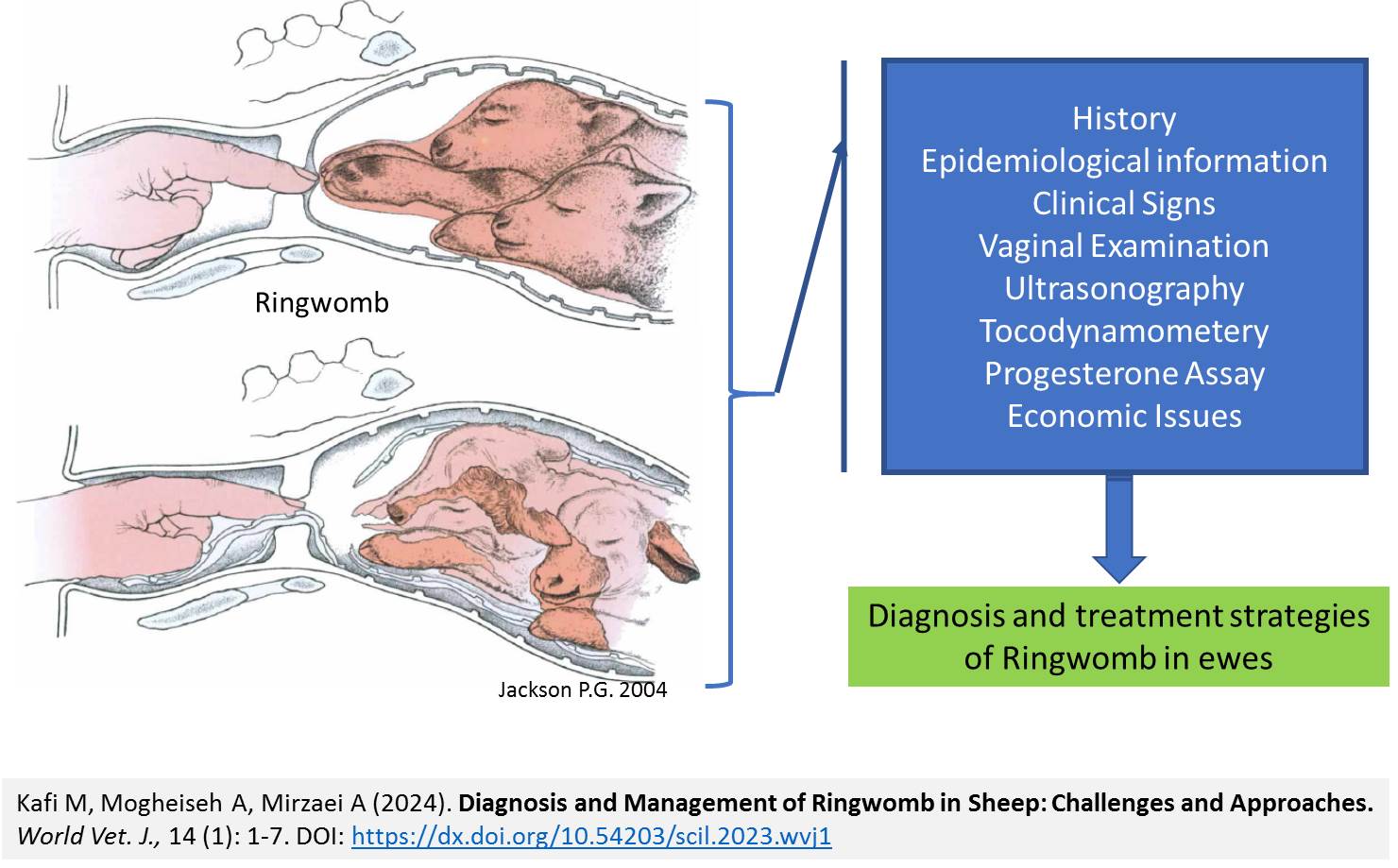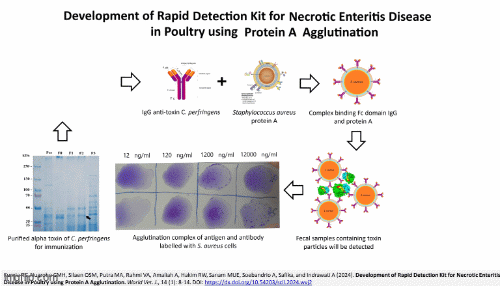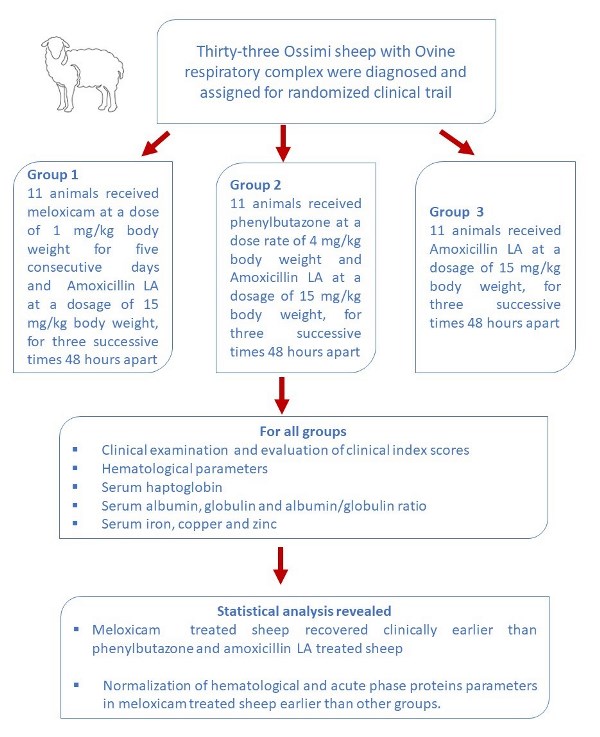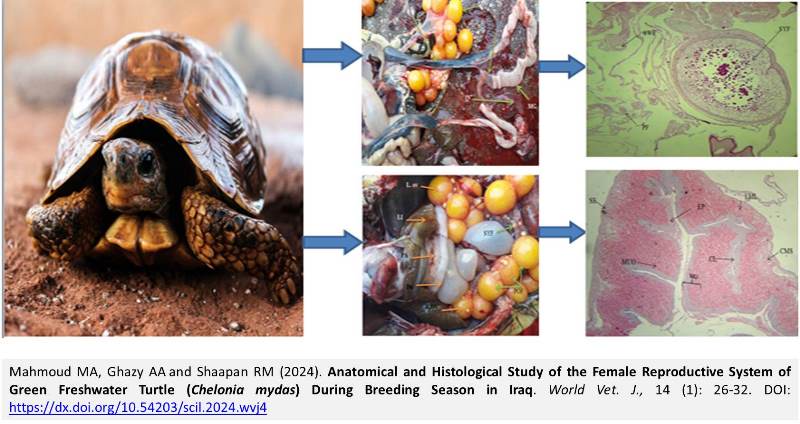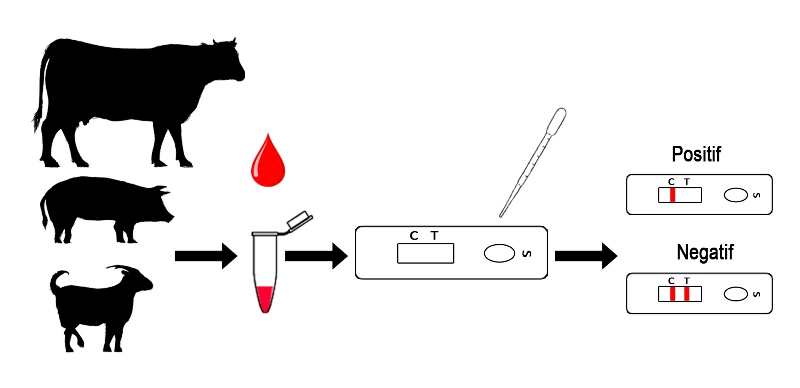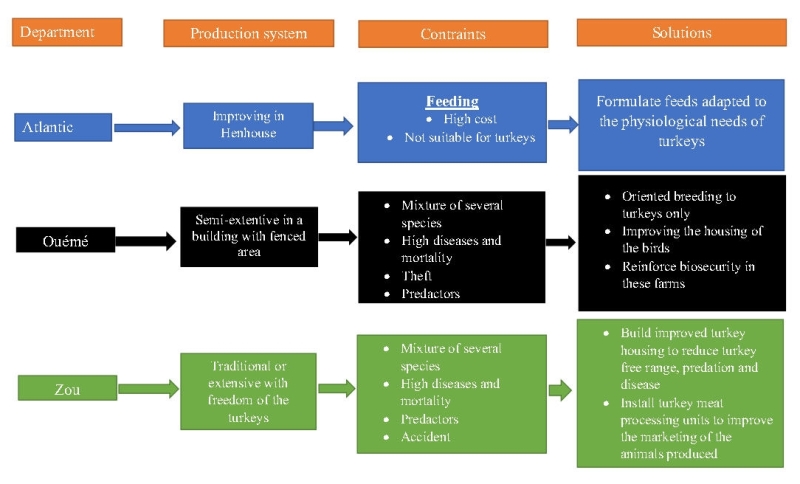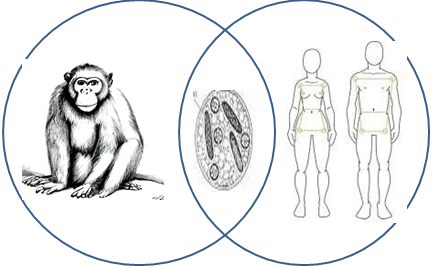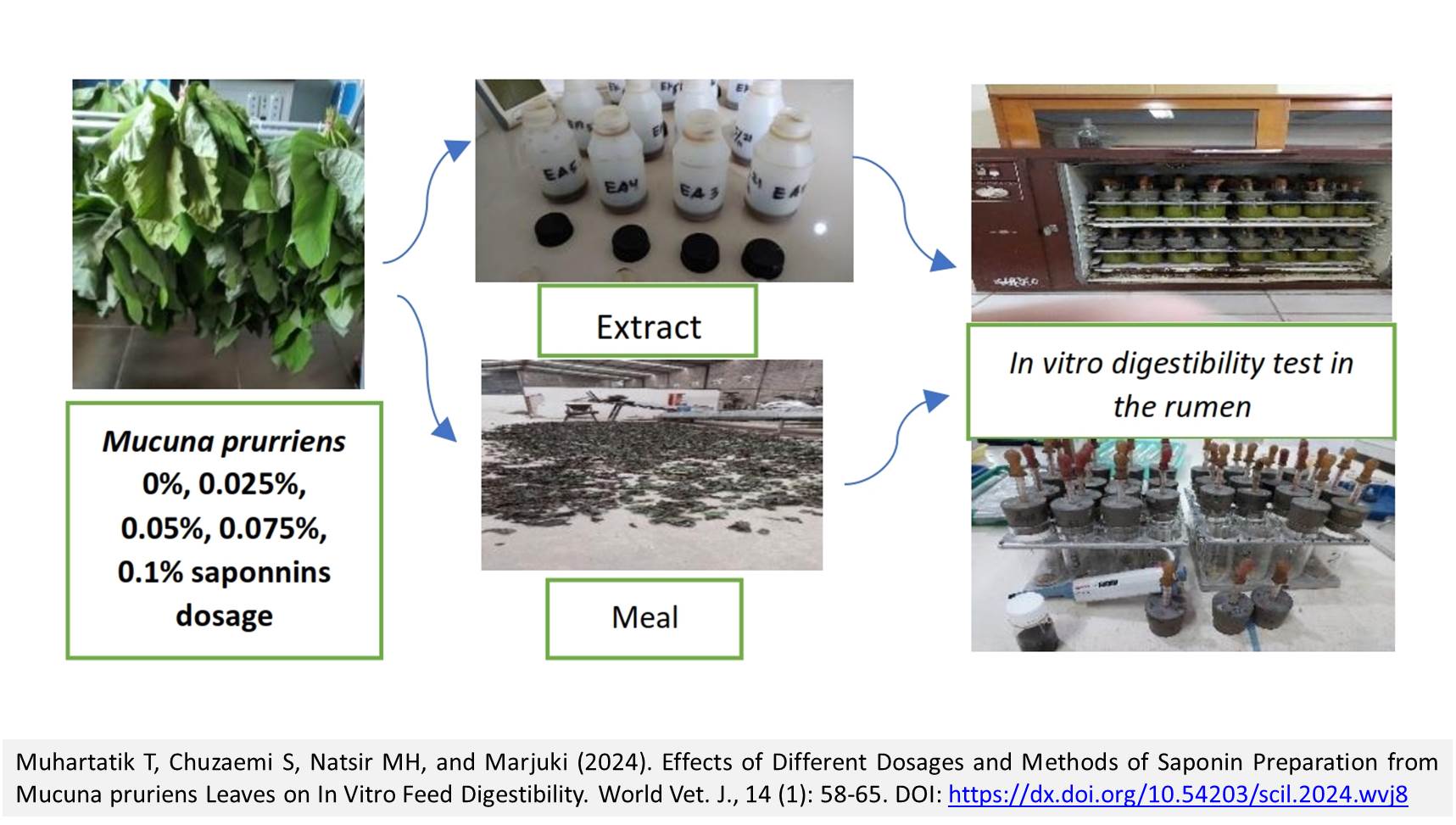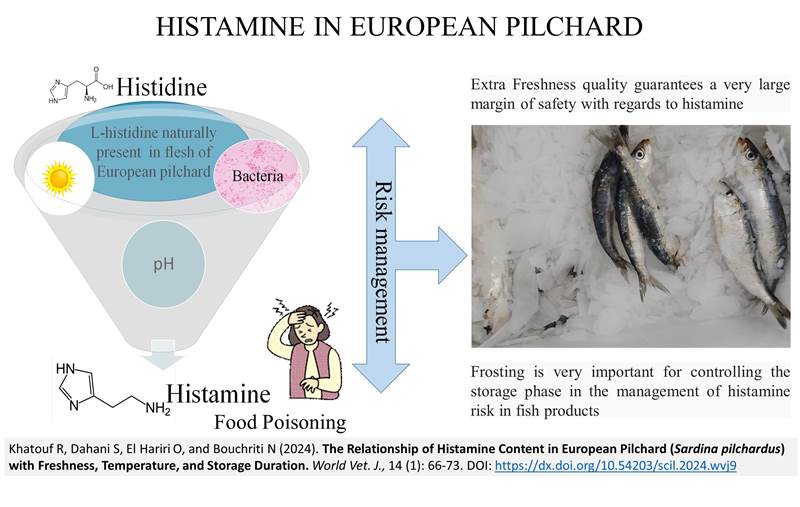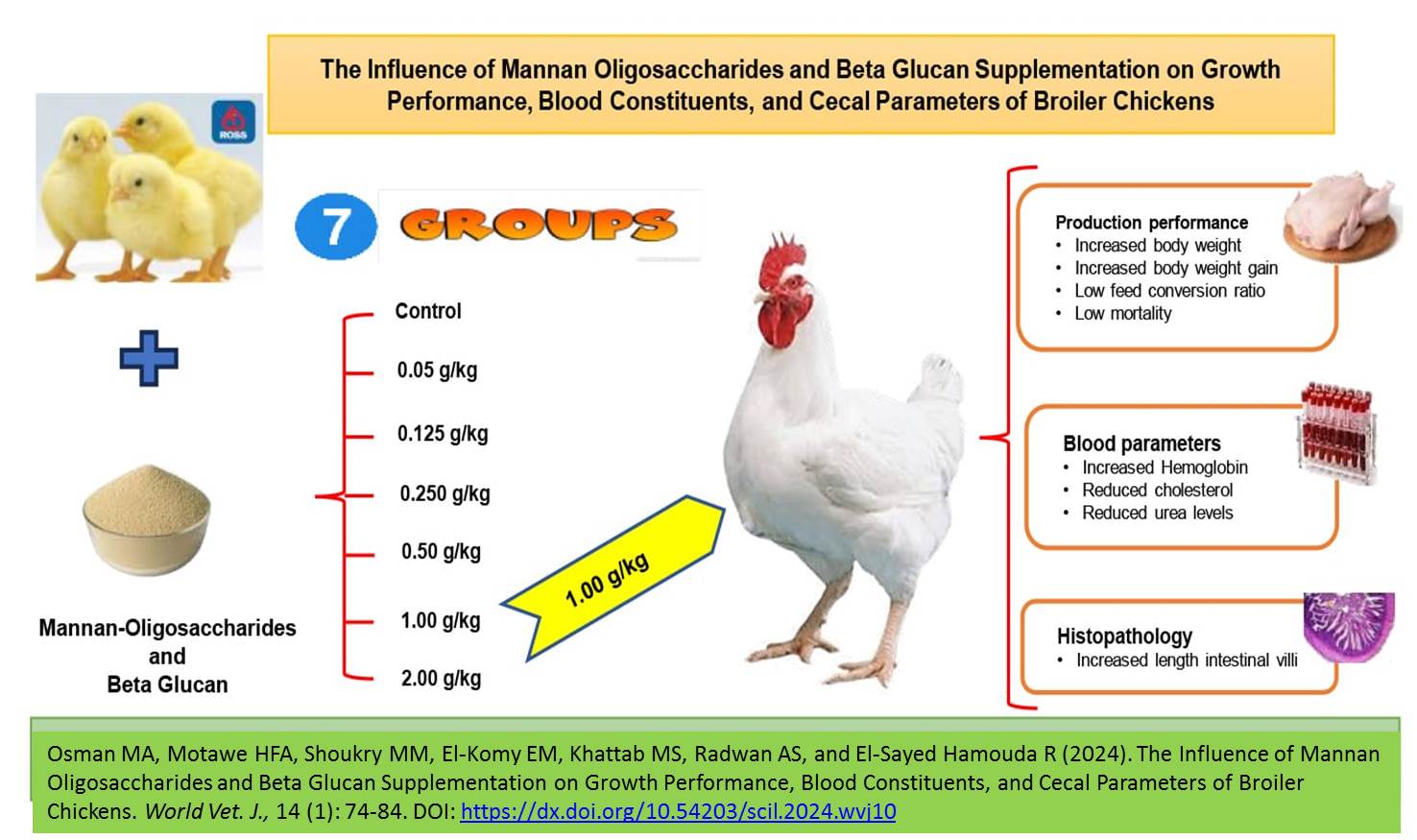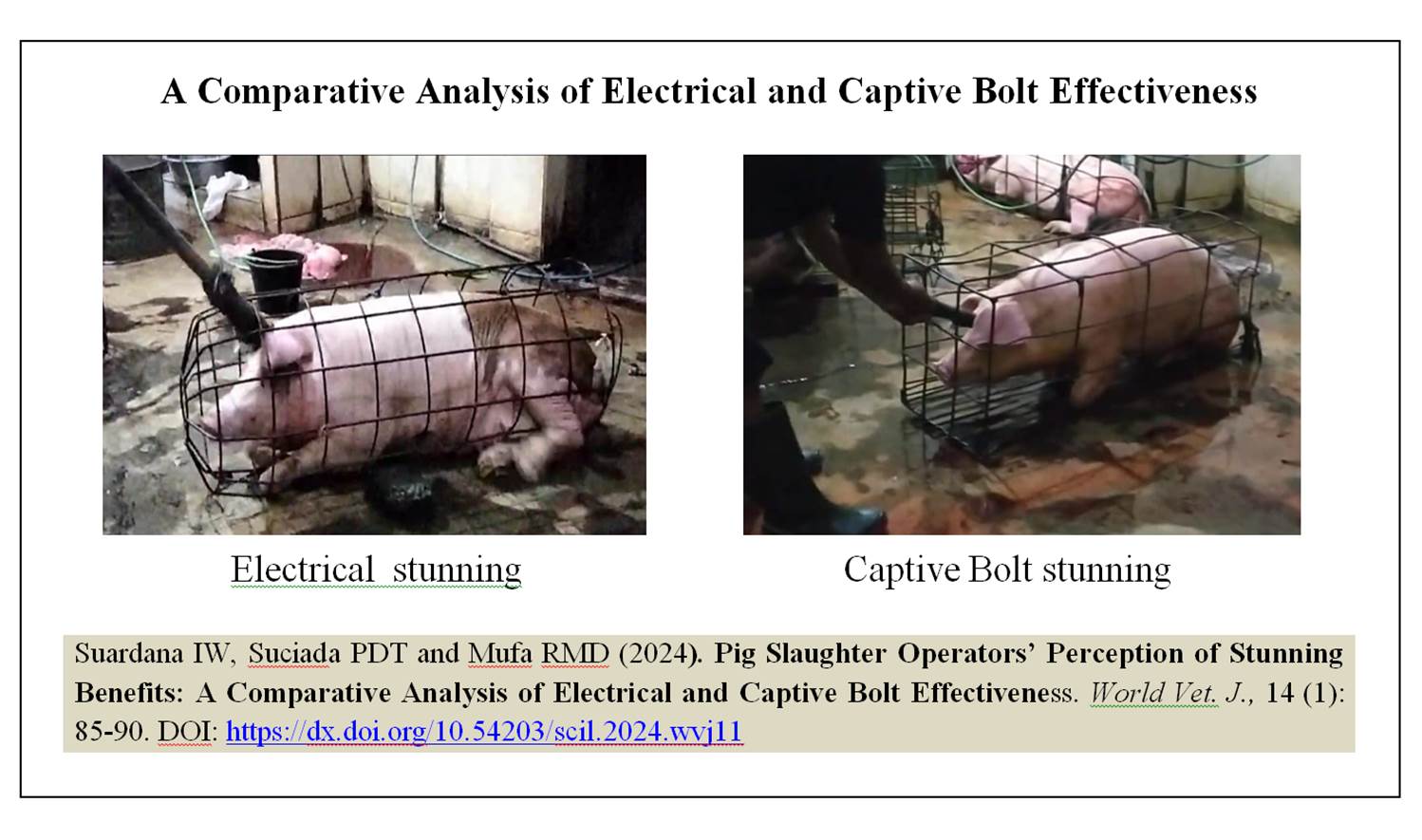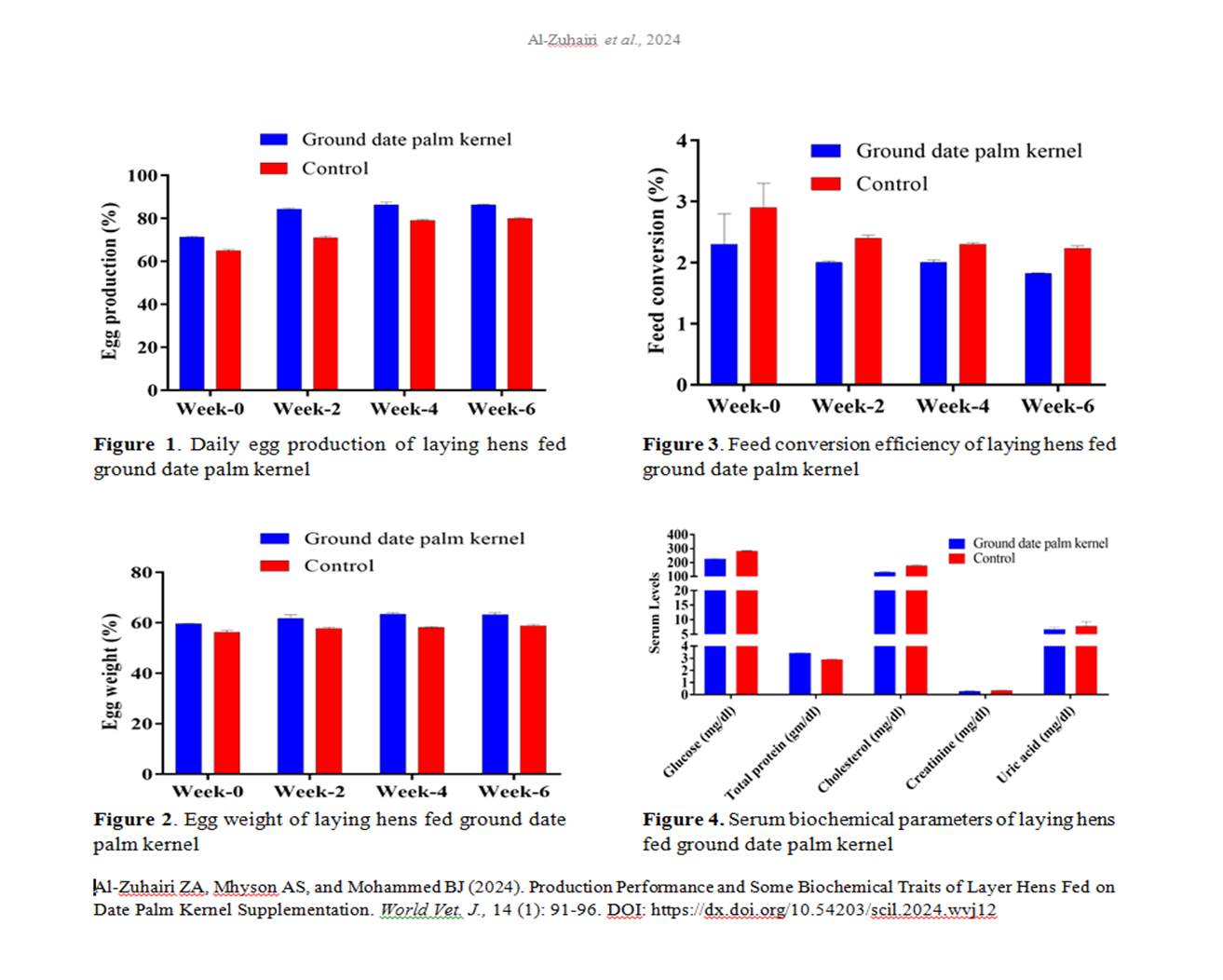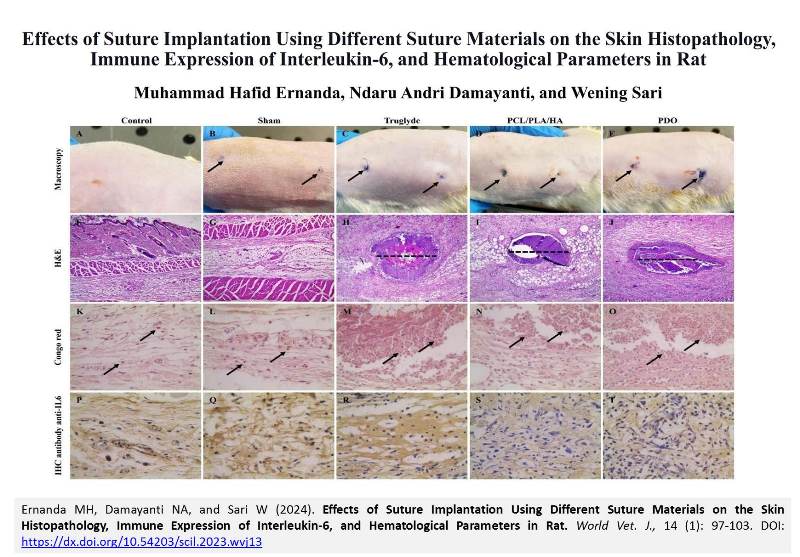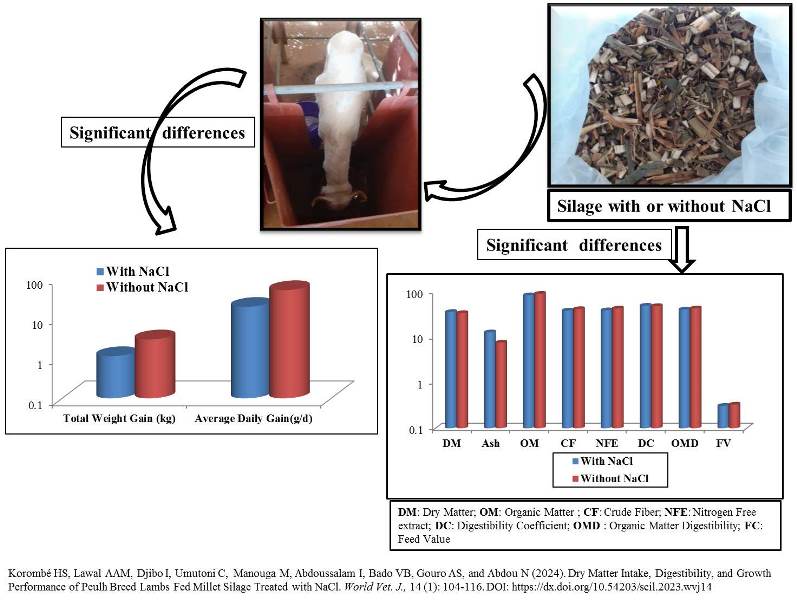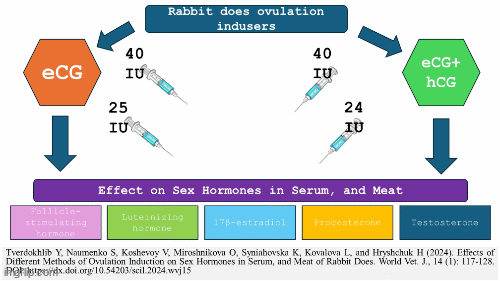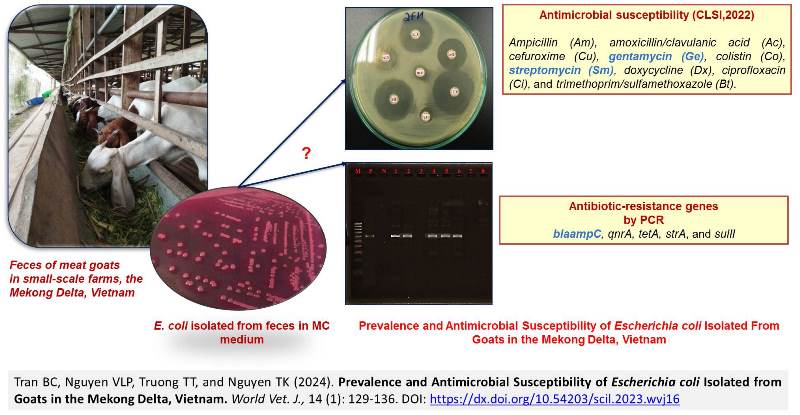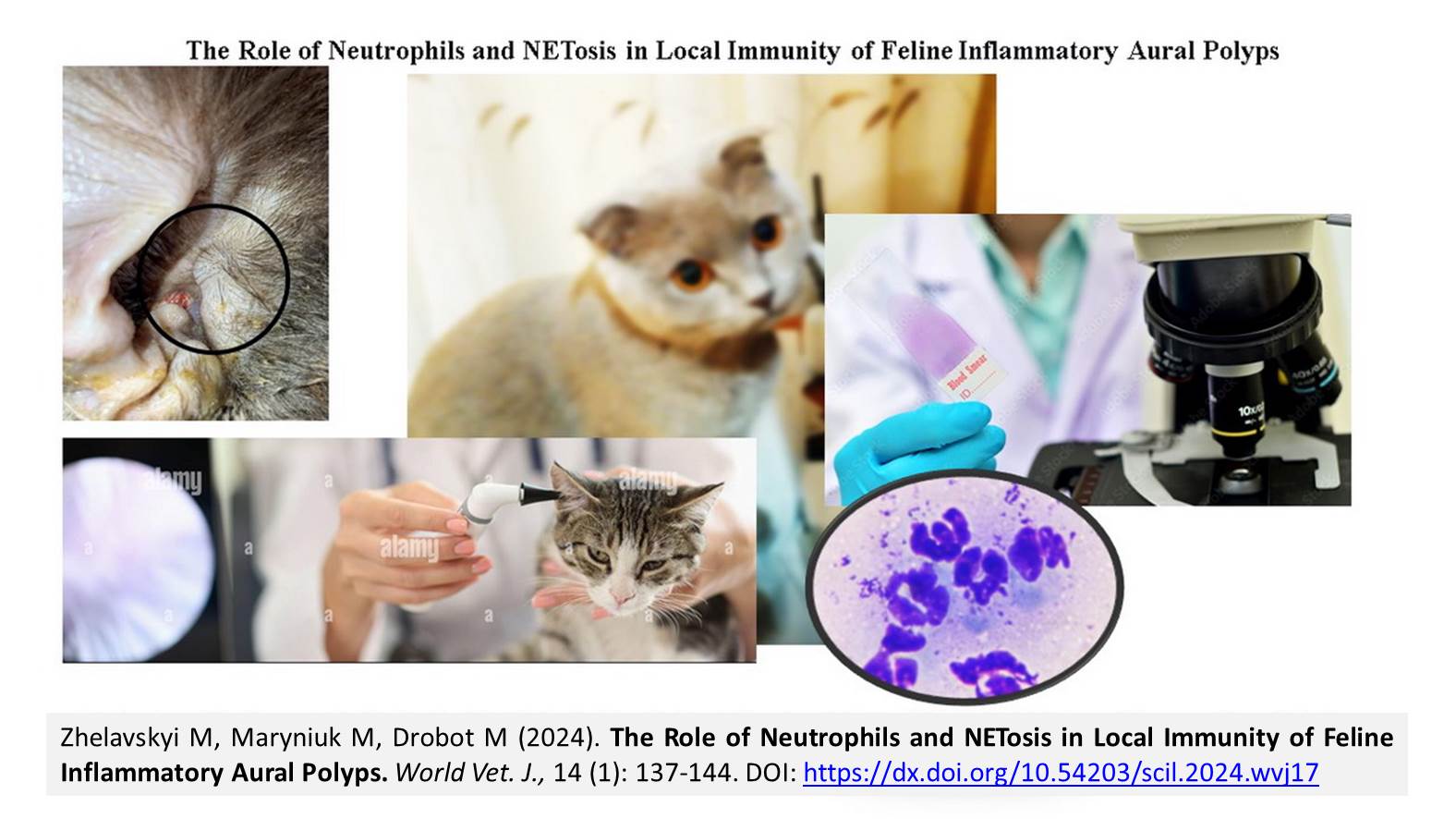Previous issue | Next issue | Archive
![]() Volume 14 (1); March, 2024 [Booklet] [EndNote XML for Agris]
Volume 14 (1); March, 2024 [Booklet] [EndNote XML for Agris]
Diagnosis and Management of Ringwomb in Sheep: Challenges and Approaches
Kafi M, Mogheiseh A, and Mirzaei A.
World Vet. J. 14(1): 1-7, 2024; pii:S232245682400001-14
DOI: https://dx.doi.org/10.54203/scil.2024.wvj1
ABSTRACT: Small ruminants, including sheep and goats, constitute a major part of the livestock population in different countries of the world. About 15-32% of sheep dystocia are due to incomplete dilation of the cervix which is often called ringwomb. This disorder typically occurs during the lambing process, prompting farmers to possibly seek veterinary assistance due to delayed labor. Different causes, such as calcium and phosphorus deficiency, uterine inertia, and fetal inability to enter the cervical canal, could all lead to incomplete dilation of the cervix. In the meantime, many cases of ringwomb occur as idiopathic. Some factors, such as genetics, nutrition, and imbalance of estrogen to progesterone concentration may also contribute to incomplete dilation of the cervix. In practice, it is important to differentiate the ringwomb with similar conditions such as false dilation of the cervix, early dilation syndrome, and vaginal prolapse associated with ringwomb. In this review, the definition of ringwomb in sheep, an exploration of the structure of the sheep’s cervix, the normal process of cervix dilation during lambing, etiology and symptoms of ringwomb, differential diagnosis, and different treatments are discussed.
Keywords: Cervix, Collagen, Dystocia, Sheep, Ringwomb
[Full text-PDF] [Crossref Metadata] [Scopus] [Export from ePrint]
Development of Rapid Detection Kit for Necrotic Enteritis Disease in Poultry using Protein A Agglutination
Kurnia RS, Nugroho CMH, Silaen OSM, Putra MA, Rahmi VA, Amaliah A, Hakim RW, Sanam MUE, Soebandrio A, Safika, and Indrawati A.
World Vet. J. 14(1): 8-14, 2024; pii:S232245682400002-14
DOI: https://dx.doi.org/10.54203/scil.2024.wvj2
ABSTRACT: Necrotic enteritis causes significant losses in the global poultry industry, necessitating accurate diagnosis for effective intervention. This study aimed to develop a diagnostic tool for detecting necrotic enteritis in poultry based on the presence of Clostridium perfringens (C. perfringens) Alpha-toxin in poultry feces. The reagent of the detection kit was developed by conjugation of IgG against C. perfringens toxin and Staphylococcus cells containing protein A. The IgG antibody was derived from an 8-month-old thin-tailed male sheep immunized with purified 2 ml of C. perfringens Alpha-toxin. Sensitivity assays were carried out to determine the detection limit, while Escherichia coli (E. coli) and Salmonella enteritidis (S. enteritidis) were used to identify specificity. A purified Alpha-toxin with a protein concentration of 2.8 mg/ml and a specific molecular weight of 43 kDa was successfully obtained. A strong reaction of the hyperimmune antibody (IgG) was also detected in the thin-tailed male sheep serum. The developed rapid detection kit in this study indicated C. perfringens Alpha-toxin with a lower concentration (12 ng/ml). Agglutination reactions could differentiate positive control from negative without significant cross-reactivity towards other bacteria (S. enteritidis and E. coli).
Keywords: Agglutination, Clostridium perfringens, Detection, Necrotic Enteritis, Toxin
[Full text-PDF] [Crossref Metadata] [Scopus] [Export from ePrint]
Comparative Effects of Meloxicam and Phenylbutazone on Clinical Outcomes and Acute Phase Response in Sheep with Acute Respiratory Disease
Alwayel A., Marzok M, Gioushy M, Kandeel M, Almubarak A, Hamad Y, Shousha S, and El-khodery S.
World Vet. J. 14(1): 15-25, 2024; pii:S232245682400003-14
DOI: https://dx.doi.org/10.54203/scil.2024.wvj3
ABSTRACT: The ovine respiratory complex (ORC) is one of the most common respiratory diseases observed in sheep. The objective of the present investigation was to evaluate the comparative therapeutic efficacy of two non-steroidal anti-inflammatory drugs (meloxicam and phenylbutazone) for the treatment of the ORC. For this purpose, 33 Ossimi sheep were randomly assigned into three treatment groups (11 each). Group 1 was treated with amoxicillin long-acting (LA) and meloxicam, group 2 received amoxicillin LA and phenylbutazone, and group 3 was treated with amoxicillin LA alone. Sheep were examined clinically and clinical index scores were recorded before and after treatment. Additionally, blood samples were collected from each sheep. After 14 days of treatment, sheep of group 1 indicated significant improvements in their clinical index scores and a reduction in total leukocyte count. However, there was a significant increase in red blood cell count, hemoglobin, and MCHC%. There was a significant decrease in the serum globulin, copper, and haptoglobin in group 1, compared to sheep of groups 2 and 3. Based on the results of this study, administering meloxicam to sheep with an ovine respiratory complex resulted in significant improvements in clinical outcomes and significant corrections in above mentioned hematological and biochemical parameters. Although phenylbutazone proved to be less effective, it still demonstrated some degree of efficacy in treating this condition. This study suggests that meloxicam may be a more effective treatment option for ORC with phenylbutazone.
Keywords: Acute phase protein, Amoxicillin, Anti-inflammatory, Ovine respiratory complex
[Full text-PDF] [Crossref Metadata] [Scopus] [Export from ePrint]
Anatomical and Histological Study of the Female Reproductive System of Green Freshwater Turtle (Chelonia mydas) During Breeding Season in Iraq
Simawy MSH, AL-Khakani SSA, Fadhil M, Jawad AI, Al-Janabi SM, Al-Rubaie DM, and Hamad RS.
World Vet. J. 14(1): 26-32, 2024; pii:S232245682400004-14
DOI: https://dx.doi.org/10.54203/scil.2024.wvj4
ABSTRACT: Turtles are found in large numbers in Iraqi rivers, due to the availability of a suitable environment for reproduction and food. The breeding season begins from May to the end of October. The current study aimed to evaluate the anatomical and histological characteristics of the green freshwater turtle (Chelonia mydas) during the breeding season in Iraq. The samples included eight adult turtles within the age range of 11-14 years that were collected from Shatt Al-Hilla (Iraq) at month June. To investigate the reproductive system histological techniques and hematoxylin and eosin staining were used and before that the animals were anesthetized with chloroform. The results indicated two active ovaries and oviducts which fill the whole abdominal cavity. The mean weights of left and right ovaries and left and right oviducts in the turtles with average weights of 698 ± 0.05 g were 19.5 ± 0.01 g, 22 ± 0.022 g, 3.3 ± 0.05 g, and 4 ± 0.05 g respectively. The mean lengths of carapace, left ovary, right ovary, left oviduct, and right oviduct were 24 ± 0.08 cm, 15.9 ± 0.01 cm, 17± 0.04 cm, 13 ± 0.022 cm, 14 ± 0.056 cm. Anatomically the oviducts include the infundibulum, magnum, isthmus, uterus, and vagina. The infundibulum indicated a funnel-shaped membrane while the magnum was the muscular coiled long tube. The isthmus was shorter and less coiled than the magnum, the uterus appeared as the widest, thickest, and less coiled dark tube and swollen into the posterior to form a cyst-like part, and the vagina was muscular in structure. Histologically, the magnum and uterus were formed from mucosa, muscularis, and serosa. In both parts of the magnum and uterus, were branched crypt-like depressions that appeared devoid of sperm. The widespread distribution of this species in Iraqi rivers could be due to the activity of the ovaries and oviducts during the breeding season, which extends for 6 months.
Keywords: Chelonia mydas, Ovary, Oviduct, Turtle
[Full text-PDF] [Crossref Metadata] [Scopus] [Export from ePrint]
Comparative Analysis of Lateral Flow Assay with Indirect ELISA for Detection of Anti-NSP Antibodies of Foot and Mouth Disease
Jauhari A, Munawaroh S, Arnafia W, Sibit D, Rahmahani J, and Suwarno S.
World Vet. J. 14(1): 33-37, 2024; pii:S232245682400005-14
DOI: https://dx.doi.org/10.54203/scil.2024.wvj5
ABSTRACT: Foot-and-mouth disease (FMD) was an exceedingly infectious disease that spread to Indonesia in May 2022. A reliable diagnostic serologic test that can distinguish between infected and vaccinated animals was an important part of FMD (serotype O) control programs in affected areas in Indonesia. For this reason, a non-structural protein (NSP) serological test based on 3ABC proteins has been used. The indirect ELISA serological test requires time, skill, and specialized equipment. An alternative method that can be employed is the lateral flow assay (LFA), which offers the advantages of simplicity and portability, enabling rapid acquisition of results. The objective of this study was to validate the efficacy of a user-friendly anti-NSP antibody LFA for rapid diagnostic purposes. This was done by assessing its sensitivity and specificity in stored samples that had previously been tested using indirect ELISA. There were 32 preserved biological materials from dairy and beef cattle in three provinces in Indonesia that were examined with developed LFA. The results of each sample on LFA were compared to the ELISA result for its sensitivity and specificity according to positive and negative values on both tests. The test had a sensitivity of 95.2% and a specificity of 100%, compared to the indirect ELISA. The measured kappa value is also very good at 0.93, so LFA can be optionally used when examining anti-NSP FMD antibodies. Therefore, the LFA anti-NSP for detecting FMD is considered reliable because of its simplicity and the accuracy of the test results.
Keywords: Antibody, Bovine serum, Foot and mouth disease, Indirect ELISA, Lateral flow assay
[Full text-PDF] [Crossref Metadata] [Scopus] [Export from ePrint]
Constraints to the Development of Turkey Farming in Southern Benin
Dotché IO, Agbokounou A, Baba L, Adebo N, Okambawa L, Koffi M, And Youssao Abdou Karim I.
World Vet. J. 14(1): 38-52, 2024; pii:S232245682400006-14
DOI: https://dx.doi.org/10.54203/scil.2024.wvj6
ABSTRACT: The turkeys are reared throughout the national territory of Benin, but their breeding is less developed than other poultry species, such as chickens and ducks. The current study aimed to characterize turkey farming in Southern Benin to identify the constraints associated with the farming practice that limit its development. A survey was performed in 104 turkey farms in the Atlantic, Ouémé, and Zou departments. The frequencies of qualitative variables and average quantitative variables were calculated and compared across departments. The investigated variables included turkey housing, feeding practices, reproduction management, health management, difficulties encountered, marketing of animals, and farm products. It was found that the housing, feeding, health monitoring, and constraints varied from one department to another. The turkeys were raised in fence-run buildings in the Ouémé (76.7%), modern poultry houses in the Atlantic (75%), and traditional habitats (42.9%) with a free range in the Zou. The free range prevented farmers from separating the turkeys from other poultry species. The poultry species present with turkeys on studied farms were chickens, ducks, and guinea fowl. The turkeys were fed more with commercial feed in the Atlantic (100%) and Ouémé (92.7%) regions and with cereals and agricultural by-products in Zou (82.1%). The prophylaxis consisted of deworming the birds, vaccinating them against Newcastle disease, controlling bacterial infections with antibiotics, and giving them vitamins in drinking water. The farmers vaccinated more turkeys in Zou than in Atlantic and Ouémé. The vaccination and administration of antibiotics do not prevent the introduction of disease into farms due to poor farm biosecurity, resulting in animal deaths. In conclusion, this study identified the obstacles that limit the development of turkey farming by region in Southern Benin. These barriers are primarily related to housing, feeding, mating, and marketing. Scientific research could potentially solve some of these issues, notably those concerning feeding and mating success. However, housing and marketing concerns would necessitate support from the authorities.
Keywords: Constraint, Feeding, Prophylaxis, Turkey
[Full text-PDF] [Crossref Metadata] [Scopus] [Export from ePrint]
Molecular Detection of Entamoeba spp. in Monkeys (Macaca spp.) in Babylon Province, Iraq
Abdul Abbas ZT and Aziz Anah S.
World Vet. J. 14(1): 53-57, 2024; pii:S232245682400007-14
DOI: https://dx.doi.org/10.54203/scil.2024.wvj7
ABSTRACT: Amoebiasis is a widespread parasitic disease caused by Entamoeba histolytica (E. histolytica), affecting various hosts, such as humans, birds, and pigs. This study aimed to investigate Entamoeba spp. in monkeys (Macaca spp.) diagnose them using molecular methods. A total of 33 fecal samples were collected from monkeys (Macaca spp.) aged 3-5 years in Babylon province to investigate a common and zoonotic parasitic disease. Initially, microscopic examination was conducted on all samples, and those yielding positive results were preserved for molecular study. The DNA was extracted, and conventional PCR was carried out with a pair of primers to detect the 857 bp fragment of E. histolytica SSU rRNA gene. PCR results for 19 fecal samples, previously identified as positive by the direct smear method, from monkeys in the reserves of Babylon province indicated that the presence of the SSUrRNA gene with an 857 bp was 45% in only 15 samples. Sequencing of the SSUrRNA gene revealed 98-100% similarity with E.histolytica sequences deposited in International GenBank, which have the sequence numbers OP522013, OP522014, OP522015, OP522016, OP522017, Op626161, Op626162, Op626163, Op626164, and Op626165.
Keywords: Entamoeba histolytica, Gene, Monkey, SSU rRNA
[Full text-PDF] [Crossref Metadata] [Scopus] [Export from ePrint]
Effects of Different Dosages and Methods of Saponin Preparation from Mucuna pruriens Leaves on In Vitro Feed Digestibility
Muhartatik T, Chuzaemi S, Natsir MH, and Marjuki.
World Vet. J. 14(1): 58-65, 2024; pii:S232245682400008-14
DOI: https://dx.doi.org/10.54203/scil.2024.wvj8
ABSTRACT: The Mucuna pruriens is commonly used in traditional medicine for anti-inflammatory, antibacterial, neuroprotector, antidiabetic, and anti-cancer purposes. The bioactive compounds, such as flavonoid, tannin, and saponin, could improve feed digestion efficiency in ruminants’ rumen. The current study aimed to evaluate the effects of different dosages and the two methods of saponin preparation from Mucuna pruriens leaves on in vitro feed digestibility parameters. A randomized block design with nested arrangements (2×5×3) was used in this study. Two methods of obtaining saponins from Mucuna pruriens leaves, including meal (MPLM) and extract (MPLE) of Mucuna pruriens leaves, were compared. The nested treatments of the preparation methods were the dosages of the saponin as feed additives in feed samples, involving 0%, 0.025%, 0.050%, 0.075%, and 0.10%. There were 15 samples in each group (five-level dosage and three repetitions). The feed contained 40% forage and 60% concentrate. The obtained results indicated that saponin preparation from Mucuna pruriens leaves (MPLM and MPLE) significantly affected dry matter, organic matter, and crude fiber rumen degradability (r-DMD, r-OMD, r-CFD, respectively), as well as NH3, volatile fatty acid, propionate, butyrate concentrations, acetate-to-propionate (A/P) ratio, acetate, and propionate percentage. However, there was no significant impact on protozoa population, acetate concentration, butyrate percentage, in vitro dry matter digestibility (IVDMD), and in vitro organic matter digestibility (IVOMD). The MPLM saponin revealed significantly higher values on digestibility parameters except for protozoa, A/P ratio, and acetate percentage. The MPLM saponin dosage of 0.05% showed the highest values for r-DMD (56.48%), r-OMD (56.51%), and r-CFD (54.64%), total Volatile fatty acid (77.71 mM), propionate (21.57 mM), propionate percentage (27.76%), IVDMD (65.95%), and IVOMD (65.86%), but lowest in A/P ratio (2.04). In conclusion, the findings of the present study suggest that the MPLM saponin at a dosage of 0.05% holds promising potential for enhancing the fermentation profile in ruminants.
Keywords: In vitro, Mucuna pruriens, Nutrient digestibility, Rumen fermentation, Saponin
[Full text-PDF] [Crossref Metadata] [Scopus] [Export from ePrint]
The Relationship of Histamine Content in European Pilchard (Sardina pilchardus) with Freshness, Temperature, and Storage Duration
Khatouf R, Dahani S, El Hariri O, and Bouchriti N.
World Vet. J. 14(1): 66-73, 2024; pii:S232245682400009-14
DOI: https://dx.doi.org/10.54203/scil.2024.wvj9
ABSTRACT: Histamine food poisoning, stemming from the consumption of certain histamine-rich fish species, such as tuna, mackerel, European pilchards, and herring, is one of the major public health issues worldwide. The present study aimed to evaluate the histamine content in fresh European pilchard (Sardina pilchardus Walbaum, 1792) of Mehdia, a coastal city in the north of Morocco. Three randomly selected batches of fresh European pilchards, each weighing 20kg, were obtained from different boats upon landing. The evolution of histamine production was monitored every 8 hours for 6 days, with one batch stored at 0°C and the other at 10°C. The organoleptic characteristics were examined considering sensory evaluation according to the rating system of European Council Regulation No. 2406/96 as common marketing standards for certain fishery products and the quality index method (QIM). The histamine content in European pilchard flesh was determined using the fluorometric method. The results indicated that the average histamine content did not exceed 5 ppm during storage at 0°C. The freshness ratings were highest during the first 3 days, corresponding to QIM values of 0 to 10 at 0°C. On days 4 and 5, the freshness ratings were on quality A, corresponding to QIM values of 11 and 12, and on the last day, they were on quality B, corresponding to a QIM value of 15 with preservation of the organoleptic quality. Statistically, a significant correlation was found between the European pilchard’s freshness and the storage duration. In contrast, this correlation between the histamine content and the storage duration was insignificant. At 10°C, the average histamine content exceeded the regulatory limit in force (100 ppm) after 32 hours of storage, and spoilage occurred on day 3. Statistical analysis revealed a strong correlation between the histamine content, storage temperature, the degree of freshness, and the duration of storage. The extra freshness quality index of European pilchard guarantees a very large margin of safety regarding histamine and can be consumed without risk.
Keywords: Degree freshness, European pilchard, Histamine, Sardine, Storage, Temperature
[Full text-PDF] [Crossref Metadata] [Scopus] [Export from ePrint]
The Influence of Mannan Oligosaccharides and Beta Glucan Supplementation on Growth Performance, Blood Constituents, and Cecal Parameters of Broiler Chickens
Osman MA, Motawe HFA, Shoukry MM, El-Komy EM, Khattab MS, Radwan AS, and El-Sayed Hamouda R.
World Vet. J. 14(1): 74-84, 2024; pii:S232245682400010-14
DOI: https://dx.doi.org/10.54203/scil.2024.wvj10
ABSTRACT: Growth promoters in poultry feed have been under severe attention since antibiotics were banned for use in animal diets by the European Union. Thus, it has been important for poultry researchers to find alternatives to antibiotic growth promoters (AGPs) to boost the health and production performance of poultry. This research was conducted to evaluate the effects of adding ALTIMOS® (cell wall of Saccharomyces cerevisiae; mannan oligosaccharides [MOS] + beta-glucan [BG]) to broiler diets on productive performance, blood parameters, intestine histopathology, and cecum microbiota of broiler chicken. A total of 252 one-day-old Ross chicks were randomly selected and divided into seven treatments, with six replicates of each treatment. The treatments were the control group (0% feed additives), and groups that received 0.05, 0.125, 0.250, 0.500, 1.0, and 2.0 g MOS+BG /kg basal diet for 35 days feeding trial. The results showed that during most trial periods, the group fed the basal diet supplemented with 1.0 g MOS+BG/kg had the highest body weight and weight gain, as well as the lowest feed consumption and best feed conversion ratio, compared to other treated groups. Moreover, this group had the best productive performance in the accumulative period. The inclusion of MOS+BG at 1.0 g/kg diet showed no significant effect on carcass percent compared to the control group. In addition, the inclusion of MOS+BG at 1.0 g/kg diet resulted in the lowest count of Escherichia coli and Enterococcus in the cecum, the highest Lactobacillus bacteria count among all experimental treatments, and a higher yeast count compared to the control group. The group fed 1.0 g MOS+BG/kg ration had the lowest blood cholesterol, whereas there were no significant differences among all experimental groups in the measured liver functions. Notably, the Hemoglobin percentage in the group fed MOS+BG at 1.0 g/kg feed was the highest. In the group fed 1.0 and 2.0 g MOS+BG/kg, the intestinal villi length was longer, and the histopathology revealed mild alteration. Overall, the supplementation of 1.0 g MOS+BG/kg diet improved growth performance, blood constituents, and cecum’s beneficial bacteria counts of broilers.
Keywords: Beta-glucan, Blood constitute, Broiler chicken, Cecal parameter, Growth Performance, Mannan Oligosaccharide
[Full text-PDF] [Crossref Metadata] [Scopus] [Export from ePrint]
Pig Slaughter Operators’ Perception of Stunning Benefits: A Comparative Analysis of Electrical and Captive Bolt Effectiveness
Suardana IW, Suciada PDT and Mufa RMD.
World Vet. J. 14(1): 85-90, 2024; pii:S232245682400011-14
DOI: https://dx.doi.org/10.54203/scil.2024.wvj11
ABSTRACT: The pre-slaughter phase, which includes stunning, aims to reduce animal stress, ensuring a more compassionate and efficient process in the meat industry. Various methods are often used in slaughtering pigs, with electrical, mechanical, and chemical stunning being the most common techniques. Several studies have shown that selecting the appropriate method requires operators to comprehensively understand the slaughter process. Therefore, this study focused on evaluating the comprehension of pig slaughter operators regarding the benefits and effectiveness of electrical and captive bolt stunning methods. A total of 17 pigs slaughtered from seven slaughterhouses were selected as samples. Data collection was carried out using questionnaires, interviews, and direct observation. The results showed that operators clearly understood the benefits of stunning in terms of speed and ease. However, their comprehension regarding pig stress reduction before death remained limited. Although captive bolt stunning was known to have various benefits, such as shortening the duration of leg movements after slaughter, it required longer operation time, compared to the electrical method. Therefore, it can be concluded that there is no ideal stunning method as both methods of electrical and captive bolt stunning have their respective advantages and disadvantages.
Keywords: Captive bolt stunning, Effectiveness, Electrical stunning, Comprehension of operator
[Full text-PDF] [Crossref Metadata] [Scopus] [Export from ePrint]
Production Performance and Some Biochemical Traits of Layer Hens Fed on Date Palm Kernel Supplementation
Al-Zuhairi ZA, Mhyson AS, and Mohammed BJ.
World Vet. J. 14(1): 91-96, 2024; pii:S232245682400012-14
DOI: https://dx.doi.org/10.54203/scil.2024.wvj12
ABSTRACT: To enhance the well-being and productivity of poultry, researchers have conducted investigations into various botanical sources, including date palm kernel, and their bioactive components. The present investigation was conducted to assess the productive performance and certain biochemical characteristics of layer hens that were administered date palm kernel supplementation in their diet. To this end, 40 ISA Brown laying hens (48 weeks old) were used in the current study. The adaptation phase for the chickens lasted for 10 days before the initiation of the experiment. The study lasted 8 weeks. The chickens were then randomly assigned into two groups of 20, with 4 replications (5 chickens per replication). Chickens in the treatment group received 5% of dry matter ground date palm kernel (GDPK), as an additive to the basal diet, and the control group (CL) chickens were fed the basal diet. The eggs were collected daily during the study. At the end of weeks 1, 2, 4, and 6 of the study, egg production percentage, egg weight, and the feed conversion ratio were measured. At the end of the experiment, blood samples were collected to measure the serum levels of glucose, total protein, cholesterol, creatinine, and uric acid. The study findings revealed significant increases in the daily egg production percentage and egg weight during the experiment in the GDPK group, compared to the CL group. The feed conversion ratio recorded significant decreases in the GDPK group when compared to the CL group. Furthermore, the findings indicated significant increases in the serum total protein and significant decreases in the glucose, cholesterol, creatinine, and uric acid concentrations in the GDPK group, compared to the CL group. In conclusion, the results indicated the positive effects of adding ground date palm kernel to the diet of layers on production performance, such as egg weight, conversion ratio, and some biochemical traits, including total protein, glucose, cholesterol, creatinine, and uric acid.
Keywords: Date palm, Egg production, Feed additive, Kernel, Laying hen
[Full text-PDF] [Crossref Metadata] [Scopus] [Export from ePrint]
Effects of Suture Implantation Using Different Suture Materials on the Skin Histopathology, Immune Expression of Interleukin-6, and Hematological Parameters in Rat
|
|
Ernanda MH, Damayanti NA, and Sari W.
World Vet. J. 14(1): 97-103, 2024; pii:S232245682400013-14
DOI: https://dx.doi.org/10.54203/scil.2024.wvj13
ABSTRACT: Suture implantation is a procedure to promote rearrangement of the extracellular matrix. Various cellular responses of post-suture implantation affect the outcome of this procedure. The current study aimed to analyze the effects of suture implantation using polycaprolactone/polylactic acid/hyaluronic acid (PCL/PLA/HA) on skin histopathology, expression of IL-6, and hematological parameters in rat models. To conduct the study, 25 male Sprague Dawley rats, three months old were randomly divided into five groups, including G1 (control), G2 (sham, group injected using skin cannula), and G3-G5 (suture implanted groups). For the suture-implanted groups, a cannula was used using suture materials. Specifically, G3 received truglyde implants, G4 received PCL/PLA/HA implants, and G5 received polydioxanone (PDO) implants. The back skin and blood samples were collected on day 3. Histopathological analysis was conducted on the samples using H and E, Congo red, immunohistochemistry against IL-6, and hematology. The analysis of the data revealed that the group with suture implantation using PCL/PLA/HA had the smallest wound area, compared to the other implanted groups. Further, the PCL/PLA/HA group showed a significant decrease in eosinophils infiltration and IL-6 level on the skin samples after suture implantation. Moreover, there were no significant differences across the groups in most of the hematological parameters after suture implantation, including total erythrocytes, hemoglobin, eosinophil, basophil, and monocyte levels. The total neutrophils increased after suture implantation in all groups, while the total lymphocytes decreased. It can be concluded that the best material according to parameters evaluated in the current study for suture implantation was PCL/PLA/HA.
Keywords: Eosinophil, Histopathology, Hyaluronic Acid, Interleukin-6, Polycaprolactone, Polylactic Acid, Suture implantation
[Full text-PDF] [Crossref Metadata] [Scopus] [Export from ePrint]
Dry Matter Intake, Digestibility, and Growth Performance of Peulh Breed Lambs Fed Millet Silage Treated with NaCl
|
|
Korombé HS, Lawal AAM, Djibo I, Umutoni C, Manouga M, Abdoussalam I, Bado VB, Gouro AS, and Abdou N.
World Vet. J. 14(1): 104-116, 2024; pii:S232245682400014-14
DOI: https://dx.doi.org/10.54203/scil.2024.wvj14
ABSTRACT: Livestock feeding is a major challenge in Niger. The aim of this study conducted at the International Crops Research Institute for the Semi-Arid Tropics (ICRISAT) experimental station in Sadoré, Niger, was to assess the effects of adding 1% NaCl to millet stover silage on the dry matter intake, digestibility, and weight performance of Peulh-bred lambs. Four treatments were tested, consisting of millet stover silages of two cultivars (Siaka Millet and Local Sadoré) with or without adding NaCl. The biological material included 32 lambs of Peulh breed Niger aged around 15 months with an average weight of 28.64 kg. They were divided into four blocks of homogeneous average weight and for each block, there were eight lambs. Each treatment was randomly assigned to a block. The trial lasted 75 days, including 15 days of adaptation and 60 days of data collection. Weight evaluation of animals was recorded, and bromatological analyses were carried out. Results indicated that there were significant differences between silages, according to NaCl addition and treatment, for some parameters of chemical composition, feed value, and zootechnical parameters of lambs. Depending on the treatment, moderately high significant differences were recorded for ash, organic matter, and crude fiber while low significant differences were recorded for digestibility coefficient and organic matter digestibility. Regarding NaCl addition, highly elevated significant differences were recorded for ash and organic matter. These differences were moderately significant for crude fiber and organic matter digestibility. Low significant differences were recorded for dry matter, nitrogen-free extract, digestibility coefficient, feed value, total weight gain, and average daily gain. It is concluded that the addition of 1% NaCl negatively affects the weight development of lambs although it improves the quality of silage parameters such as dry matter, ash, and digestibility coefficient.
Keywords: Millet residue, Salt, Sheep, Silage, Ruminant feed, Zootechnical performance.
[Full text-PDF] [Crossref Metadata] [Scopus] [Export from ePrint]
Effects of Different Methods of Ovulation Induction on Sex Hormones in Serum, and Meat of Rabbit Does
|
|
Tverdokhlib Y, Naumenko S, Koshevoy V, Miroshnikova O, Syniahovska K, Kovalova L, and Hryshchuk H.
World Vet. J. 14(1): 117-128, 2024; pii:S232245682400015-14
DOI: https://dx.doi.org/10.54203/scil.2024.wvj15
ABSTRACT: High indicators of reproductive function in rabbits can be achieved using hormonal inducers of ovulation, in particular analogs of gonadotropin-releasing hormone, serum, and chorionic gonadotropins. Therefore, the aim of this study was to evaluate the dynamics of sex hormones in the blood serum and meat of rabbit does during ovulation stimulation over 5 consecutive pregnancies. For this purpose, 60 Hyla rabbit does were randomly divided into five groups of 12, ensuring four animals per group with three replicates. Animals of the first and second experimental groups, animals received intramuscular injections of serum gonadotropin, 40 IU and 25 IU respectively, three days prior to artificial insemination. Females of the third and fourth groups were administered combined doses of serum and chorionic gonadotropins (40 IU and 24 IU, respectively) during the same period. Rabbits of the control group were stimulated to ovulate by subcutaneous injection of 0.2 ml analog of gonadotropin-releasing hormone after artificial insemination. Long-term administration of gonadotropins revealed dose-dependent effects. Hyperprogesteronemia was detected in rabbit does (40 IU), while hyperandrogenia was noted in females (24 IU) during the combined administration of gonadotropins. The use of serum gonadotropin at a dose of 25 IU contributed to an increase in the level of follicle-stimulating, luteinizing hormone and progesterone while decreasing 17β-estradiol. A high dose (40 IU) in rabbit does did not cause significant fluctuations of hormones in blood serum, but decreased luteinizing hormone and progesterone. Long-term use of a gonadotropin-releasing hormone analog was accompanied by a pronounced decrease in the level of luteinizing hormone, as well as 17β-estradiol. However, the meat of all experimental animals did not increase the content of steroid hormones (testosterone and 17β-estradiol). It can be concluded that ovulation stimulation in rabbit does using a serum gonadotropin dose of 25 IU and the recommended dose of a gonadotropin-releasing hormone analog does not negatively impact the hormonal balance.
Keywords: Analogue of gonadotropin-releasing hormone, Artificial insemination, Equine chorionic gonadotropin, Human chorionic gonadotropin, Rabbit does
[Full text-PDF] [Crossref Metadata] [Scopus] [Export from ePrint]
Prevalence and Antimicrobial Susceptibility of Escherichia coli Isolated from Goats in the Mekong Delta, Vietnam
|
|
Tran BC, Nguyen VLP, Truong TT, and Nguyen TK.
World Vet. J. 14(1): 129-136, 2024; pii:S232245682400016-14
DOI: https://dx.doi.org/10.54203/scil.2024.wvj16
ABSTRACT: Escherichia coli is one of the severe pathogens causing severe diarrhea and resistance to antibiotics in domestic animals, including goats. From April to June 2023, 122 fresh feces of hybrid Boer goats of different ages and genders were collected randomly in the small-scale farms in the Mekong Delta, Vietnam, to clarify the prevalence and antibiotic resistance of E. coli isolated from those feces. By the traditional culture method, of 122 samples, 87 fecal samples were positive for E. coli (71.31%). There were no statistically significant differences in the prevalence of E. coli among male or female goats and ages (< 6 months and ≥ 6 months). E. coli was detected in goats over 6 months and under 6 months at 76.56% and 65.52%, respectively, while 88.20% and 85.42% in male and female goats. The antimicrobial susceptibility of E. coli strains to 7 examined antibiotics was conducted using the Kirby-Bauer disk diffusion method. The results indicated that E. coli was sensitive 100% to colistin (10 μg), amoxicillin/clavulanic acid (20/10 μg), cefuroxime (30 μg), doxycycline (30 μg), ciprofloxacin (5 μg), and 87.50% to ampicillin (10 μg) and bactrim (trimethoprim/sulfamethoxazole, 1.25/23.75 μg), respectively. However, those E. coli strains were highly resistant to streptomycin (93.75%), and 93.67% of E. coli strains were resistant to one to three antibiotics. Among them, the resistant pattern of Ge+Sm (gentamycin + streptomycin) was the most frequent detection (43.75%). The prevalence rate of antibiotic resistance genes (blaampC, tetA, qnrA, strA, and sulII) in E. coli strains isolated from goat feces was detected by PCR. Among them, gene blaampC was the most predominant (96.88%), followed by qnrA (68.75%). Furthermore, 81.25% of E. coli strains harbored two to five antibiotic-resistance genes, and the gene pattern of blaampC + tetA + qnrA was the most popular (21.88 %). The antibiotic resistance and harbored antibiotic resistance genes in E. coli strains isolated from goat feces increase animal and public health concerns.
Keywords: Antibiotic resistance gene, Antimicrobial susceptibility, E. coli, Goat, Small-scale farm
[Full text-PDF] [Crossref Metadata] [Scopus] [Export from ePrint]
The Role of Neutrophils and NETosis in Local Immunity of Feline Inflammatory Aural Polyps
|
|
Zhelavskyi M, Maryniuk M, Drobot M.
World Vet. J. 14(1): 137-144, 2024; pii:S232245682400017-14
DOI: https://dx.doi.org/10.54203/scil.2024.wvj17
ABSTRACT: Feline inflammatory aural polyps are abnormal growths that can occur in the ear canals of cats, particularly in the middle ear. These polyps are frequently linked to persistent inflammation and can result in a range of ear-related complicated pathologies. The etiology is multifactorial. The purpose of the research was to study the cytology of an inflammatory polyp in a cat and to study the role of neutrophils and their mechanisms on the formation of extracellular protective traps by neutrophils (NETs). A 4-year-old, female spayed, Scottish fold cat, weighing 3.5 kg sent to a veterinary clinic (Mirra-Vet, Kyiv, Ukraine). Clinical, otoscopic methods, and laboratory methods of cytological diagnostics were used for the research. At the onset of the clinical investigation, exudate discharge from the ear and a painful response were observed. Upon detailed otoscopy, a polyp in the ear canal was diagnosed. An increase in the number of leukocytes (23.2×109/L), their absolute content, and an increase in the percentage of neutrophils (48.2 %) in the leukogram. Assessing the capacity of neutrophils to generate NETs (Neutrophil Extracellular Traps) was determined after samples were collected using a cytologic brush. Cytological analysis of samples from the inter-tragic incisure area highlighted a significant presence of neutrophils, forming extracellular protective traps. The results revealed free NETs in separate areas of the slides. The findings indicated the formation of cooperative groups among neutrophils, other phagocytes, and epithelial cells, along with slender nuclear streaks. During the treatment (Otoflox, 2 drops per ear), the inflammatory reaction disappears, polyp size decreases, exudative reactions decrease, and neutrophil activity decreases. After 3 days of treatment, the animal's condition improved. The ear was clean without sulfur and lesions. The complete treatment course spanned 7 days. During the treatment, the inflammatory reaction disappeared, polyp size decreased, exudative reactions decreased, and neutrophil activity decreased. Experimental studies have shown that during the inflammatory reaction in the ear, protective mechanisms of local immune defense are activated. Activated neutrophils perform their function through phagocytosis and the formation of NETs. These studies contribute to supplementing the data on the immunopathological mechanisms of feline inflammatory polyps.
Keywords: Ear polyps, Feline inflammatory, Local immunity, Neutrophils
[Full text-PDF] [Crossref Metadata] [Scopus] [Export from ePrint]
Research Paper
The Effects of Different Concentrations of Vitamin D3 on Immunological Parameters of Immunosuppressed Rats Induced
|
|
Kmosh SM, and Al-Naely AJ.
World Vet. J. 14(1): 145-150, 2024; pii:S232245682400018-14
DOI: https://dx.doi.org/10.54203/scil.2024.wvj18
ABSTRACT: Vitamin D3 receptor is expressed in several types of immune cells suggesting that Vitamin D3 could have immune regulatory roles. The current study was conducted to investigate the role of Vitamin D3 in reducing the toxicity of the cisplatin on some Immunological parameters in the rat model. The current experiment was conducted on 80 adult white male rats within the age range of 9-12 weeks. The animals were divided into eight groups (10 animals in each group). The control group was dosed with the physiological solution until the end of experiment (C). Rats in the second treatment were injected with cisplatin (2 mg/kg, T1). Rats in the third (T2), fourth (T3), and fifth (T4) groups were injected with cisplatin at a concentration (2 mg/kg) and received Vitamin D3 at levels of 5000 IU, 10,000 IU, and 15,000 IU, respectively. The rats in the sixth (T5), seventh (T6), and eighth (T7) groups were subjected to Vitamin D3 at concentrations of 5000 IU,10,000 IU, and 15,000 IU, respectively. At the end of the experiment, which lasted 21 days, the animals were anesthetized, their weights were recorded, and blood samples were collected. The findings revealed a significant elevation in the levels of interleukin-12, tumor necrosis factor-alpha, C-reactive protein, lymphocyte percentage, monocyte percentage, and eosinophil percentage within group T1 compared to the control and other treatment groups that received Vitamin D3. The average percentage of white blood cells and neutrophils in group T1 was significantly lesser than other groups. It can be concluded that supplementation of different Vitamin D3 levels (5000-10,000 IU) have positive influences on the immunological parameters of immunosuppressed rats.
Keywords: Cisplatin, Immunosuppressant, Interleukin, Vitamin D3
[Full text-PDF] [Crossref Metadata] [Scopus] [Export from ePrint]
Previous issue | Next issue | Archive
![]() This work is licensed under a Creative Commons Attribution 4.0 International License (CC BY 4.0).
This work is licensed under a Creative Commons Attribution 4.0 International License (CC BY 4.0).



